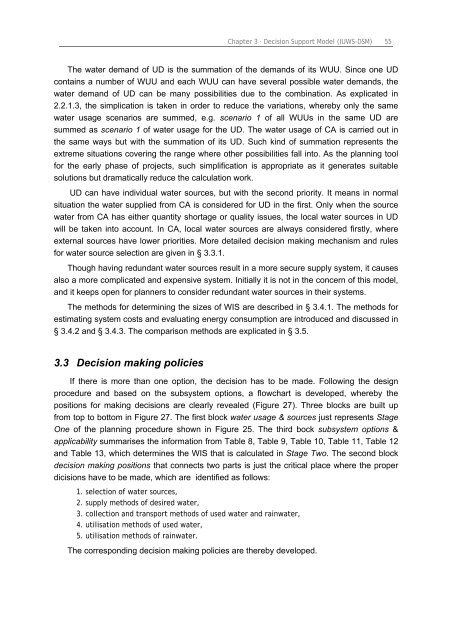Chapter 3 Decision Support Model (IUWS-DSM) - Tubdok
Chapter 3 Decision Support Model (IUWS-DSM) - Tubdok
Chapter 3 Decision Support Model (IUWS-DSM) - Tubdok
You also want an ePaper? Increase the reach of your titles
YUMPU automatically turns print PDFs into web optimized ePapers that Google loves.
<strong>Chapter</strong> 3 · <strong>Decision</strong> <strong>Support</strong> <strong>Model</strong> (<strong>IUWS</strong>-<strong>DSM</strong>) 55<br />
The water demand of UD is the summation of the demands of its WUU. Since one UD<br />
contains a number of WUU and each WUU can have several possible water demands, the<br />
water demand of UD can be many possibilities due to the combination. As explicated in<br />
2.2.1.3, the simplication is taken in order to reduce the variations, whereby only the same<br />
water usage scenarios are summed, e.g. scenario 1 of all WUUs in the same UD are<br />
summed as scenario 1 of water usage for the UD. The water usage of CA is carried out in<br />
the same ways but with the summation of its UD. Such kind of summation represents the<br />
extreme situations covering the range where other possibilities fall into. As the planning tool<br />
for the early phase of projects, such simplification is appropriate as it generates suitable<br />
solutions but dramatically reduce the calculation work.<br />
UD can have individual water sources, but with the second priority. It means in normal<br />
situation the water supplied from CA is considered for UD in the first. Only when the source<br />
water from CA has either quantity shortage or quality issues, the local water sources in UD<br />
will be taken into account. In CA, local water sources are always considered firstly, where<br />
external sources have lower priorities. More detailed decision making mechanism and rules<br />
for water source selection are given in § 3.3.1.<br />
Though having redundant water sources result in a more secure supply system, it causes<br />
also a more complicated and expensive system. Initially it is not in the concern of this model,<br />
and it keeps open for planners to consider redundant water sources in their systems.<br />
The methods for determining the sizes of WIS are described in § 3.4.1. The methods for<br />
estimating system costs and evaluating energy consumption are introduced and discussed in<br />
§ 3.4.2 and § 3.4.3. The comparison methods are explicated in § 3.5.<br />
3.3 <strong>Decision</strong> making policies<br />
If there is more than one option, the decision has to be made. Following the design<br />
procedure and based on the subsystem options, a flowchart is developed, whereby the<br />
positions for making decisions are clearly revealed (Figure 27). Three blocks are built up<br />
from top to bottom in Figure 27. The first block water usage & sources just represents Stage<br />
One of the planning procedure shown in Figure 25. The third bock subsystem options &<br />
applicability summarises the information from Table 8, Table 9, Table 10, Table 11, Table 12<br />
and Table 13, which determines the WIS that is calculated in Stage Two. The second block<br />
decision making positions that connects two parts is just the critical place where the proper<br />
dicisions have to be made, which are identified as follows:<br />
1. selection of water sources,<br />
2. supply methods of desired water,<br />
3. collection and transport methods of used water and rainwater,<br />
4. utilisation methods of used water,<br />
5. utilisation methods of rainwater.<br />
The corresponding decision making policies are thereby developed.

















